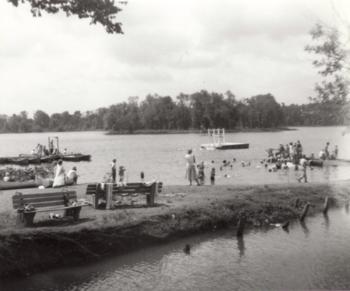Growing Up In Waterford, PA

Growing Up In Waterford, PA |
 |
When now-common household appliances seemed miraculousFort LeBoeuf Class of 1956 |
I was thinking about our home appliances the other day. That's what happens when you're retired and have time to think.
I've thought about almost everything, and am now down to reminiscing about home appliances, specifically our first refrigerator. It was a new 1941 Philco, the last of the pre-war refrigerators. It was wonderful! There was a light inside, and you could actually freeze water and make little blocks of ice! You could even make ice cream! (We did; just once; it was awful.)
Inside the refrigerator were "crisper" drawers for vegetables, and a meat-keeper drawer under the freezing compartment. Below the door was a tilt-out potato bin.
If you're wondering why we were so excited about our new Philco, it's because it was replacing our old ice box. Ice boxes were sort of wooden cupboards with three or four doors. One of the doors opened to hold a block of ice, usually 25 or 50 pounds; the other doors revealed food compartments. A pan underneath caught meltwater.
Ice used to be cut out of Presque Isle Bay each winter and stored in insulated ice houses for summer use.
Back home in Waterford, there was a time when ice was harvested from Lake LeBoeuf. It was cut by hand with big cross-cut saws (by the Williamson brothers, Bob and Jim) and hauled away on bobsleds pulled by teams of horses. Since the teams and sleds were driven out onto the lake, the ice must have been pretty thick. All this was before my time. I wish I could have seen it. Ice for our ice box was manufactured, probably by the Koehler Brewing Company.
Forrest "Smiles" Moore delivered ice all around Waterford, stopping at homes that had ice cards in the windows (a square card with the word "ICE" in big letters).
Sometimes in the summer we needed ice between deliveries. There were small ice houses at the Mobil and Keystone gas stations. In the late '30s and early '40s, cars had bumpers made of heavy steel that stuck out a foot or so in front of and behind the car. A cake of ice fit nicely between the bumper and front fender if you set it in cornerwise. That's the way everyone hauled ice.
Nowadays, with all the talk about food poisoning and this bacteria and that bacteria, I wonder how all we ice box users ever survived.
My earliest memories of a kitchen stove are of a three-burner Perfection kerosene range. The burners used circular wicks which were lighted with a match and turned up and down with brass knobs. They were connected to a pipe carrying the kerosene from a glass reservoir that sat in a bracket on the end of the stove and held about a gallon of kerosene.
Around 1943, we got a Magic Chef gas range. It used bottled gas since there were no natural gas lines in Waterford then. Like the refrigerator, the gas stove was wondrous! Just turn a knob and on comes the flame!
But even more wondrous was the gas water heater. As long as the bottled gas lines were being installed for the stove, Dad had a water heater put in. Prior to that, our hot water came from a large tea kettle or pan on the kitchen stove. Mom heated water for laundry in a big galvanized tank that sat on another kerosene stove, similar to the kitchen range, in the back shed off the kitchen.
Talk about high tech! After the water heater was connected, we could get hot water right out of the faucet! It almost made a kid want to take a bath. I said "almost."
Mom did the washing in our Montgomery Wards' wringer-washer. A garden hose was connected to the drain valve so that the washer drained out onto the lawn. What a great place to slosh around in bare feet and pick up fishing worms. Worms do not like soap suds in their burrows, so they come to the surface in a hurry. And they are very clean.
The old wringer-washer lasted until 1951. When sparks and fire began to fly out of the motor as it was plugged in, Mom and Dad decided it was time for a new one.
They purchased a new Maytag automatic. This was really state of the art! It filled, it drained, it washed, it rinsed, it spun! And it did this all by itself! It was the smartest machine I had ever seen!
These were the days before sewage treatment plants and sewer lines. All the houses in Waterford were on septic tanks and cess pools. We were living in our new house by this time, and we had a cess pool for a basement drain. (For the younger generation, technologically a cess pool is a hole in the ground).
The basement drain was adequate for our needs. At least it had been up until now. Unlike the wringer-washer, which drained by gravity in the form of a slow drizzle, the new automatic pumped its water out. The first time we used it, we found our cess pool didn't quite soak up the water fast enough. In fact, after the first ten seconds of draining, we had a fountain of hot, soapy water shooting up out of the drain!
I suppose we could have shut it off, but this was the inaugural load of clothes! We hadn't even had time to read the instructions yet! So while the fountain continued, we scurried around trying to get things up off the floor before they got soaked. Dad finally got things fixed. It turned out the drain tile was partially plugged. The cess pool itself was plenty large enough.
So much for appliances. There were times I've thought my life hasn't been exciting. Imagine that!